

Nantucket Conservation Foundation Celebrates Our 60 th Year
STAFF

President & CEO
Cormac Collier
Vice President of Science and Stewardship
Karen C. Beattie
Director of Research and Partnerships
Dr. Jennifer M. Karberg
Director of Donor Relations & Marketing
Jeff Coakley
Chair
John Macfarlane III
Vice Chair
Todd M. Knutson
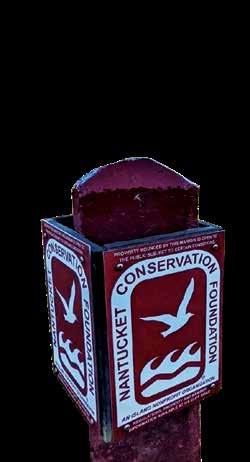
Director of Land Management
Nicholas J. Larrabee
Wildlife Research Ecologist
Danielle O’Dell
Plant Research Ecologist/Botanist
Kelly A. Omand
Interpretive Education
Coordinator/Ecologist
Neil P. Foley
Development Associate
Mara Weiner
BOARD OF TRUSTEES
OFFICERS
Secretary
Lucinda Young
Lindsey Gund
Laura Hanson
Marketing and Outreach Manager
Allison Levy
Accounting Associate Korilynn Adams
Land Use Manager
Jim Olney
Properties Maintenance
Donald J. Mack
Richard H. Mack
Sean Mack
Treasurer
Charles K. Gifford, Jr.
TRUSTEES
Edward V. Lahey, Jr.
Bonnie McCausland
James Meehan
Daphne F. Mitchell
Sherwood Newell
Ann B. Oliver
Clerk
Marianne R. Stanton
Diane R. Pearl, MD
David Rattner
Dr. Geoffrey C. Trussell
MISSION
The mission of the Nantucket Conservation Foundation is to assist in the preservation of Nantucket’s character by permanently conserving, maintaining, and managing natural areas and habitats and to encourage an appreciation of and interest in the Island’s natural resources.
Assistant Clerk
Mary West
Rick Ulmer
Patrick S. Wayland



Message from the President
Sixty years ago, nine members of the Nantucket community joined together for the sole purpose of protecting Nantucket’s open space and safeguarding it for generations to come. Their passion and dedication to preserve Nantucket’s incredible environment was the catalyst for the formation of the Nantucket Conservation Foundation. With the first donation of the “Bird Sanctuary”, 0.9 acres on North Beach Street, we have grown to over 9000 acres; representing over one third of the island. From Coatue to Eel Point, Sanford Farm to Squam Forest, the Conservation Foundation offers hundreds of miles of trails to traverse and explore, providing a refuge for both mind and body.
Over the coming year, we invite you to join our 60th anniversary celebration. In the following pages you will see the impact of our scientific research, the dedication of our land management team, and the abundant opportunities available to the community to learn and be enriched. On behalf of our past and present trustees and staff, thank you for your support over the years. We look forward to another 60 years of success! In appreciation,

INSIDE

Cormac Collier President & CEO

60 Years of Dedication to Conservation
Maintaining the natural beauty of Nantucket’s environment requires careful planning, continuing public education and vigilant ongoing action.
CONSERVATION & STEWARDSHIP
The majority of the land held by the Foundation has been generously donated by individuals, organizations, estates, bequests, and trusts. The Foundation continues to strategically purchase tracts of land with conservation value that abut or are in close proximity to other conservation properties. Additionally, we monitor and protect the many rare plants and wildlife that inhabit our properties. Our efforts include heathland and grassland restoration, inventory and protection of endangered species, as well as property management.
ECOLOGICAL RESEARCH
The Foundation’s Department of Science and Stewardship uses research and monitoring to gain understanding of the ecology of Nantucket’s rare plants, wildlife and habitats across our properties. This helps inform our management and conservation decisions and contributes to broader ecological research in New England and beyond.
EDUCATION & OUTREACH
An important part of our mission is to familiarize our visitors with the natural and cultural history of our properties. Our popular “Mornings for Members” & “Science Excursions” walks facilitate interaction with Foundation representatives who provide detailed information about our properties. In addition, we develop guides, maps, interpretive signs, and educational materials for our properties.
PROPERTY EXPERIENCES
Many more people are visiting our properties during the summer and shoulder seasons, so we are working hard on trail management, creating new trails, and enhancing our mobile app ACKTrails to improve your experience. Our trails are maintained year-round for visitors to explore the island during every season.
PUBLIC SERVICE TO THE COMMUNITY
We strive to deepen our mission by educating our neighbors about the ecology of Nantucket. In addition to public excursions, we also offer the annual Race For Open Space, and will be bringing back the popular Nantucket Harvest Fair and Batacular Bike Race









Looking Out for the Southern Pine Beetle
Southern pine beetles (Dendroctonus frontalis) are a tiny, blackishbrown beetle, less than 1/8 of an inch and about half the length of a grain of rice. They are in the family of “bark beetles” that bore in to and feed on the inner bark layer, or phloem. Some bark beetles can be major forest pests and have caused extensive damage to conifer forests in the western and southern US. Southern pine beetles are native to the southern US, ranging from as far west as Arizona and New Mexico, and as far north as Pennsylvania and southern New Jersey. However, thanks to climate change and milder winters, they have been marching northward into New York and New England. The advance of southern pine beetles is a major concern for land managers responsible for pitch pine stands.
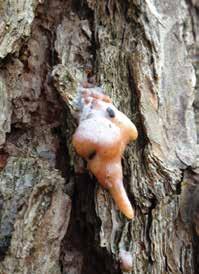

Signs of southern pine beetles on pitch pine. On Left, popcorn-shaped resin mass containing beetles. On Right, S-shaped tunnels under bark. Images courtesy of UMass Amherst website –https://ag.umass.edu/landscape/fact-sheets/southern-pine-beetle
The Science and Stewardship Department at NCF has been working closely with researchers from the Massachusetts Department of Conservation and Recreation to monitor for the presence of southern pine beetles on Nantucket since 2018. Sadly, the results of the survey from this past spring are not encouraging, with southern pine beetles found in all three traps in late May and early June. They were also found on Cape Cod and in traps throughout southeastern Massachusetts. It seems the beetles have finally arrived.
The presence of the beetles on island now is not necessarily cause for immediate panic but certainly warrants continued surveillance and vigilance. Southern pine beetle populations can exist at low,
endemic levels where they persist on weakened or dead trees. At low population levels, healthy trees that become infested can usually ward off an attack by producing resin that leaks out of the tree where the beetle burrowed in through the bark. These sticky “pitch tubes” entrap the beetles and force them out of tree. However, a major outbreak at epidemic levels of southern pine beetles can very quickly overwhelm the defenses of a healthy tree, killing it in as little as two months. These outbreaks can move quickly through stands of trees, causing widespread damage to pine forests. The result of an unchecked infestation is a forest full of standing, dead and dry pine trees that may pose a wildfire hazard.
The closest and most recent outbreak began in 2014 in the Central Pine Barrens of Long Island, NY and has caused extensive damage to pitch pine forests throughout Suffolk County. Since that initial outbreak, beetles have been detected as far north as the Albany Pine Bush although an outbreak has not yet occurred outside of Long Island.
As with all invasive species, our motto at NCF is early detection, rapid response. Controlling a pest after it is established is difficult and expensive, if not completely impossible. The sooner we can detect a species after it arrives, the better chance we have of getting ahead of it.
We can certainly use help in spotting southern pine beetles in our pitch pine forests! As you walk through pine forests on Nantucket, keep an eye out for pitch or white pine trees that have the following tell-tale signs of southern pine beetle infestation:
• Sudden reddening or browning of needles
• Pitch tubes or popcorn-sized resin masses on the bark all the way up the tree
• Scattered, tiny holes in the bark where beetles have entered the tree
• S-shaped trails or tunnels in the tissue of the tree underneath the bark

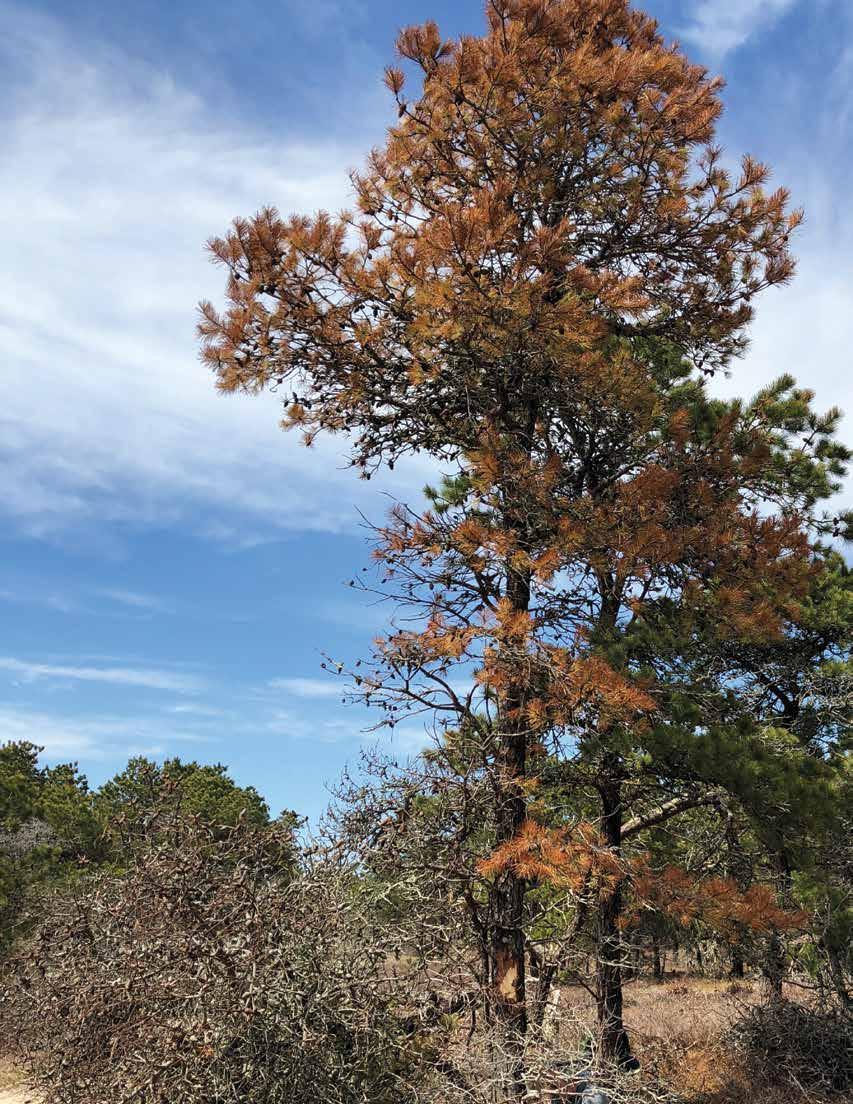


Southern pine beetles can be easily confused with other beetle species that also inhabit pine trees. The closely related but native Black Turpentine beetle (Dendroctonus terebrans) is very common on Nantucket and can also cause damage to pine trees. These beetles usually affect trees that have been weakened from stressors such as salt spray and wind from strong winter storms. Black turpentine beetles are about three times the size of a southern pine beetle. Damage is generally contained to the bottom six feet of the tree whereas the southern pine beetle will be found up and down the entire trunk. The exit holes scattered in the bark are much larger, as are the pitch tubes which are about an inch wide, white, and tend to ooze down the bark. When in doubt, report any infestation you find and we will be happy to check it out.
NCF is now preparing for and considering measures to take in order to make our forests more resilient to an infestation and to slow the progression of an outbreak, should one occur. Recommendations from lessons learned on Long Island include:
• Proactive thinning of pine forests before the beetles arrive. This is good forestry practice and promotes a healthier ecosystem that will be better able to withstand infestation.
• Immediate cutting of infested trees. This cutting does not kill the beetles in the tree but it disrupts pheromone production and the ability of beetles to communicate via pheromones.
• Thinning of pine trees around an infestation.
The pitch pine forests on Nantucket host unique communities of plants and animals. Over the last few years, our research has shown how valuable they are to rare and endangered species such as New England Cottontails and Northern long-eared bats. As you walk through these beautiful forests, please help us by learning to recognize the signs of a beetle infestation and if you see something, say something! Reach out to us at the Nantucket Conservation Foundation at (508) 228-2884 or email dodell@ nantucketconservation.org , and if possible, pictures and exact location would be especially helpful!
Pitch pine tree in the Middle Moors of Nantucket with reddened needles due to damage from black turpentine beetles.
Photo: Danielle O’Dell
Support the Nantucket Conservation Foundation
We love when you, our Nantucket neighbors, enjoy the experiences of visiting, walking, running, or biking our 9,000 acres of properties throughout the island. Land management and trails maintenance are a costly endeavor, and we count on contributions from our members to keep our properties as pristine as possible. Please consider becoming a member, gifting a membership, or renewing your membership with us today.

•$50 Friend
•$100 Supporter
•$250 Steward
•$500 Donor
MEMBERSHIP LEVELS
•$1,000 Sponsor
•$2,500 Patron
•$5,000 Benefactor
•$10,000 Conservator
•$25,000 Defender
•$50,000 Protector

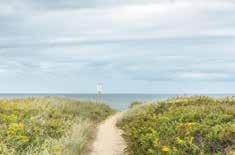



The Growth of NCF’s Native Plant Gardens

If you’ve visited the NCF office at 118 Cliff Road over the last few years, you may have noticed dramatic changes! In 2019, our Land Management staff removed invasive species and prepared the site for a major landscaping renovation. Our first plantings of native shrubs and trees took place in 2020, along with planting of a diverse native wildflower meadow.
Gracious support from a Nantucket Garden Club grant enabled us to include educational signs about plant species ecology and identification. In 2021 we continued to expand our plantings and evolve the office landscaping and educational outreach with a series of popular garden tours led by staff Plant Ecologist and Botanist, Kelly Omand.
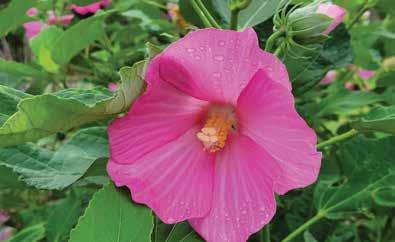
Highlights of this season’s garden work included removing some unhealthy non-native conifers to expand the wildflower meadow, transplanting shrubs around the office entrance area to better suit site conditions and needs, and planning for additional plant material to enhance the landscape in the spring. In the gardens, a recently transplanted rose mallow (Hibiscus moscheutos) grown from an island seed, captured the limelight for much of the summer. Its dramatic display of enormous pink flowers and deerrepelling super-powers impressed us all!
This season we were also honored to receive a Conservation Commendation from the Nantucket Garden Club and Nantucket Land Council for our wildflower meadow under the “Pollinator Garden” category. This new award program recognizes island gardens and gardeners for their work in protecting biodiversity and improving water quality, encouraging gardeners around the island to plant natives and garden ecologically.
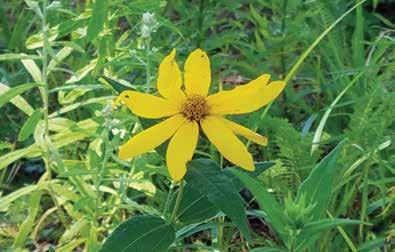
Our native plant garden drew additional interest from ReMain Nantucket’s new Footprints Virtual Garden Tours effort this season. ReMain is working with non-profit partners and gardeners to create a series of virtual garden tours that will be made available online. These tours will focus on sustainable and resilient gardens within the island community, ranging from rainwater capture gardens to sustainable no-mow lawns. Stay tuned to experience these innovative garden tours when they are released and experience the NCF office gardens in a new way!
For now, the native plant gardens are tucked in for a winter nap, protected by deer fencing until spring. But be sure to keep an eye out for new plantings next season, and to sign up for upcoming native plant landscaping tours.

Woodland Sunflower (Helianthus divaricatus)
Swamp Rose mallow (Hibiscus moscheutos).
Pasture thistle (Cirsium pumilum).



Coast to Coast

This fall Neil Foley, Interpretive Education Coordinator & Ecologist, walked segments of the Coast to Coast Trail with a weekly group of Nantucketers as part of a new guided excursion series. Starting off in September, they took their time completing the 24.7 miles over 7 weeks. This made the lengthy route approachable for older folks and those who can’t do the Nantucket Land Bank’s annual Cross-island Hike in one day.
This epic trail was established in 2019 by the Nantucket Land Bank, Mass Audubon, and the Nantucket Conservation Foundation to be a community resource and connect us all over the appreciation of Nantucket’s conservation land. Only about 3 miles of the journey is paved, so most of your time traversing the entire island is spent immersed in the beautiful open space that our three organizations protect.
“I love walking this trail and taking in the many habitats across the island, but as always the most enjoyable part was getting to know the people I was walking with,” said Foley. “A huge thank you to Kathy Grieder who approached me with the idea and helped to organize such a fun group. I had a blast talking with everyone along the way, catching up about each week’s events, and pointing out fun ecology things we encountered.” Another huge thank you to Guthrie Diamond from the Nantucket Land Bank who not only walked so much of the route with us this year but was integral to laying out this beautiful trail in 2019.
If you want to see the route for yourself, download it on the ACKTrails App. You can also come grab a paper map version from our office at 118 Cliff Rd or the Nantucket Land Bank’s office downtown. We will be offering this Coast to Coast walk series again this fall so if you want to get on the list send Neil an email (nfoley@nantucketconservation.org).





Profiles

STAFF SPOTLIGHT: Dr. Jennifer Karberg
BOARD SPOTLIGHT: John G. Macfarlane III
In his 16 years as an NCF Trustee, John Macfarlane has gained the respect and confidence of our Board of Trustees and Advisors to act as our new Chair of the Board. First coming to the island in 1981, John and his family fell in love and have returned every year since, spending plenty of time on the biking and running trails around Milestone Bog & Larsen Acres. We are excited to have John guide us through the next steps in this exciting time in the Foundation’s history and the role he will play in this new decade of NCF.

Dr. Jen Karberg’s new role as the Director of Research & Partnerships reflects her dedication to our renowned ecology research program while building stronger partnerships with other organizations, institutions, and researchers. Her considerable experience as a published Wetland Ecologist have greatly supported our understanding and management of the habitats we protect while her thoughtfulness and diplomatic nature represent us to the community at large through her role on the Nantucket Coastal Resiliency Advisory Committee. We are so lucky to have her expertise and leadership in the next era of NCF.

SPECIES SPOTLIGHT:
Northern Saw-whet Owl (Aegolius acadius) These small, but mighty predators can sometimes be heard calling through late winter nights on Nantucket. Only measuring about 8 inches from head to tail, male Saw-whets sit on branches in patches of conifer trees and make deceptively loud calls for a nest partner. From less than 20 feet off the ground they send a high-pitched, repetitive “toot, toot, toot, toot, toot…” that echoes through forest, swamps and over rolling hillsides. Once they pair up for the season in February and March, Saw-whets move to nesting cavities in predominantly deciduous woods for the breeding season. There they feed on the many voles and small rodents active in the understory at night time. Listen on these calm winter nights for the sound of a Saw-whet Owl and know that winter is waning.



PROPERTY SPOTLIGHT: Windswept Bog
It’s an exciting time in the history of Windswept Bog. The project design plans for our freshwater wetland restoration project are entering the next stages and we are working with our partners at Massachusetts Division of Ecological Restoration to bring the plans forward in a meaningful way. Windswept doesn’t just serve an important ecological role; so many people love to walk, bike and explore this property and use it as a fantastic gateway to the Middle Moors. We plan to maintain and improve this public access as a critical part of the designs. Join our Winter Walk at Windswept Bog on Saturday February 25th to hear more of the next steps and what is in store.
Northern Saw-whet Owl
Photo: eBird, Kenny Miller)

2023 Winter Walks
To view the calendar and to register please go to: support.nantucketconservation.org/site/Calendar
FEBRUARY
Sunday February 5, 11am-12:30pm
Tupancy Links
Hear the story of restoring a golf course into the sprawling native grasslands they are today and the species that share it with us. Known as one of the best dog walking trails and sunset viewing spots on the island, come find new things to appreciate about this island treasure.
MARCH
Sunday March 5, 11am-12:30pm
Ram Pasture
Explore the southernmost end of the Foundation’s popular Sanford Farm property, which is home to some of Nantucket’s rarest habitats, plants and animals. This area, which is also rich in cultural history, offers spectacular views of the ocean and the open grasslands of our adjacent Head of the Plains properties.
APRIL
Sunday April 2, 11am-12:30pm Heart of the Middle Moors
Wind through the scrubland and kettle hole ponds at the heart of Nantucket’s expansive Middle Moors. We’ll talk about the historic and ecological value of these isolated wetlands and see the protection of Nantucket’s open landscape in a new light.
Saturday February 25, 11am-12:30pm Windswept Bog
Join us for a guided walk around the bogs and forests of Windswept, a retired organic cranberry bog on a restoration journey back into more functioning wetland. Hear about the ecological history in the making for this island favorite and the cranberry culture that helped to sustain the families of Nantucket after the whaling era.
Sunday March 19, 11am-12:30pm
Masquetuck
Travel the short loop through a small, fascinating hardwood forest that extends to the shores of West Polpis Harbor with opportunities to see winter ducks, talk shellfish, and see the benefits to other residents of this ecologically rich area.
Sunday April 30, 11am-12:30pm
The Walk to Altar Rock
Traverse the Serengeti into the center of Nantucket’s Middle Moors on the first guided hike along our Walk to Altar Rock trail. Opening to expansive views of this Glacial outwash plain, hear about the everchanging ecology of this landscape and see Nantucket’s hilly moraine in a new way.




Land Management
The work doesn’t end when the grass stops growing for the season. In fact, our dedicated Land Management crew is as busy as ever protecting our grasslands and heathlands through science-minded rotational mowing of scrub oak and maintaining our series of protective firebreaks. The harsh winter winds blow through tractor cab doors and the woodier 2-3 year old scrub oak takes a toll on the machines and the drivers. All for the sake of lower-growing species and younger oaks that support more species of pollinators when the spring and summer arrive. We wait
until the winter to avoid any impact on nesting birds or insects, but the growing season is right around the corner. So much of the important work begins before the buds of our plants open in the spring sun.
On top of that habitat management, strong northeast winds can take down limbs and trunks of trees across our many wooded trails. We need to stay on top of any potential windblow to keep these trails clear from hazards and safe to explore.
If you see something unusual or illegal happening on one of our properties, please email nlarrabee@nantucketconservation.org or give our office a call at 508-228-2884.
OPEN SPACES
Nantucket Conservation Foundation
PO Box 13, Nantucket, MA 02554
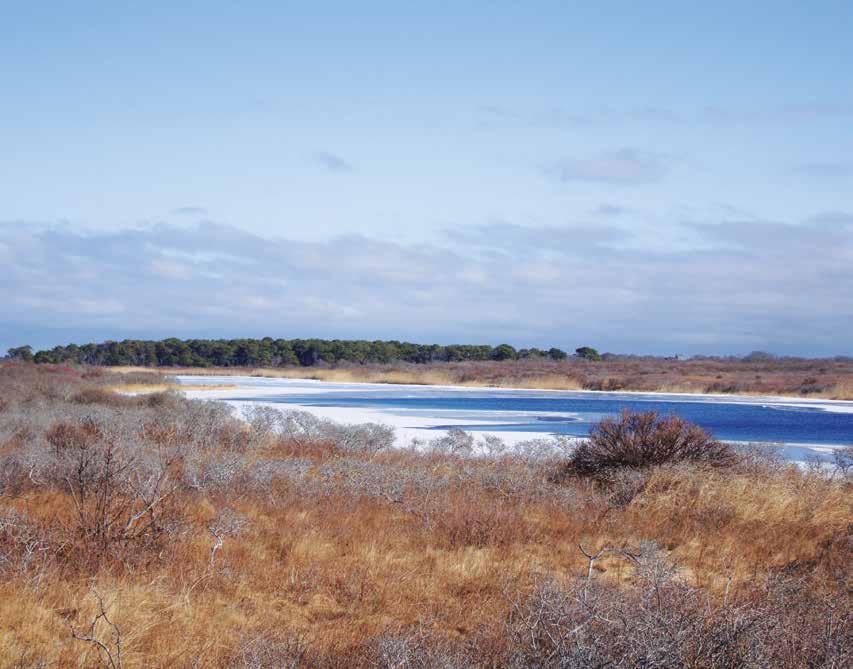
Give someone the gift that will last forever: the gift of open space.
Do you know someone who cares for Nantucket as much as you do? A gift membership to the Foundation is a great way to celebrate your common commitment to preserve open spaces and natural habitats for rare and endangered species on the island. Each membership comes with a subscription to the Foundation’s newsletter and publications, property map, membership decal, and invitations to the Mornings for Members and Science Excursions during the year.
To gift a membership, scan the flowcode below or visit our website at www.nantucketconservation.org/support
Thank you for your support!

